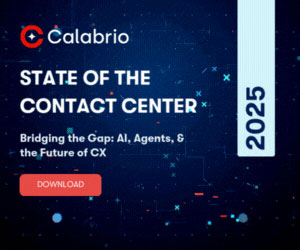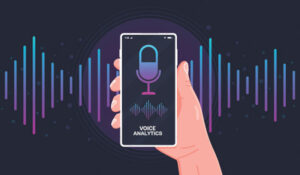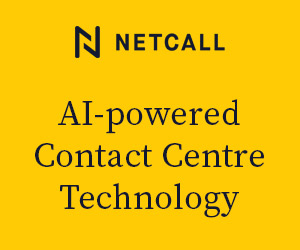Calabrio explores how voice analytics leverages AI to transform customer conversations into actionable insights, enabling contact centres to analyse sentiment, detect patterns, and uncover opportunities for improvement.
In the data-driven contact centre of today, understanding the nuances of customer conversations is paramount. And with the help of voice analytics solutions, call centres can leverage AI to turn the voice of the customer into a source of valuable insights.
What Is Voice Analytics?
Voice analytics, in short, is technology that transforms spoken words into actionable insights.
By leveraging artificial intelligence, particularly natural language processing (NLP) and machine learning, voice analytics software analyses audio recordings and live calls to extract valuable information about customer sentiment, intent, and behaviour.
This process is particularly useful in the contact centre – site of countless, and crucial, customer conversations – where it enables businesses to optimize operations, enhance customer experiences, and drive more strategic decision-making.
Essentially, voice analytics can unlock the hidden potential within your contact centre’s conversations – and turn your interactions into a competitive advantage.
Voice Analytics vs. Speech Analytics: Understanding the Nuances
Voice analytics technologies have flourished in the enterprise contact centre, especially with the latest advances in AI. (Indeed, the voice analytics market is only expected to continue booming, reaching nearly $3 billion USD in size by the end of this decade.)
As solutions have advanced, the terms “voice analytics” and “speech analytics” have become interchangeable. However, looking back to the terms’ roots, there are subtle yet significant distinctions worth noting.
Traditionally, speech analytics in the contact center primarily focused on the transcription and analysis of what was said, converting spoken words into text and identifying keywords or phrases.
Voice analytics, on the other hand, represents an evolution of this technology, placing a greater emphasis on how something was said. It delves deeper into the emotional and contextual layers of speech.
Essentially, speech analytics is a foundational element within the broader scope of voice analytics, which leverages advanced AI to provide a more comprehensive and nuanced understanding of conversations.
And in the realm of the contact centre, both terms fall within the scope of interaction analytics solutions and conversation intelligence.
The Role of AI in Voice Analytics
AI is now already responsible for no shortage of innovations in an array of industries, including in the contact centre. But what exactly makes it so crucial to voice analytics tools?
For one, it’s AI that enables voice analytics technology to decode, analyse, and interpret voice data from customer interactions, enabling a deeper understanding of customer needs, behaviours, and emotions.
For instance, advanced, AI-driven voice analytics can discern a customer’s emotional state – such as frustration, satisfaction, or confusion – from factors like their tone of voice, speech pace, and choice of words.
This added emotional intelligence allows businesses to tailor their responses to each person’s needs and concerns, improving engagement and overall contact centre customer experiences.
Plus, AI has driven an increase in the capacity of contact centre tools. With AI, you can analyse vast amounts of voice data in real time. This analysis identifies patterns, trends, and insights that would be impossible for humans to detect manually.
AI can also predict future customer behaviours and preferences by harnessing historical interaction data and current conversation contexts.
This predictive power is invaluable for personalizing customer interactions and delivering targeted, relevant content and offers, as well as improving responses to issues that arise.
How Does Voice Analytics Work?
Voice analytics software analyses recordings and live conversations to extract valuable information. Steps include:
Audio Capture
The voice analytics process begins with the capture of voice communications.
It can be done through various means, including phone calls, voice messages, or any other audio recording method – but it’s typically all handled by a contact centre call recording solution that’s offered as a standalone tool or as part of a CCaaS or workforce engagement management software platform.
Modern systems handle both high-quality digital recordings and lower-quality audio inputs.
Speech-to-Text Conversion
The next step involves converting the spoken words into text through speech-recognition technologies, which have evolved significantly in recent years thanks to advances in AI.
These technologies now more accurately transcribe complex and nuanced speech, even in the presence of background noise or varying accents.
Natural Language Processing (NLP)
With NLP, the system is able to interpret the context of customer conversations, identifying key phrases, topics, and the overall sentiment of the speech. This step is crucial for understanding what was said and the intent behind the words.
Data and Sentiment Analysis
The final stage transforms raw data into actionable intelligence. Advanced algorithms and machine learning models analyse processed data, uncovering trends, patterns, and anomalies.
Beyond simple positive, negative, or neutral sentiment detection, near real-time analysis allows agents and managers to pinpoint specific emotional cues.
This includes identifying emotions like annoyance, excitement, or indecision, providing a comprehensive understanding of customer sentiment that enables proactive and targeted interventions.
Benefits of Voice Analytics
McKinsey’s research shows that traditional customer feedback methods only capture less than 2% of all voice interactions, leading to incomplete and unrepresentative data sets.
These findings confirm the need for voice analytics software for full customer insights. However, the benefits offered by voice analytics software in the contact centre extend well beyond greater coverage.
Topic Tracking and Issue Identification
Voice analytics identifies customer satisfaction levels by analysing recurring themes, trends, and sentiment within conversations.
This data allows businesses to address customer service needs more effectively and personalize their offerings.
Improved Sales Opportunities
Voice analytics solutions uncover missed opportunities by monitoring customer calls for specific terms and processes. Insights gained from voice data inform strategies to enhance contact center productivity and boost services and sales.
Customer Loyalty and Retention
Through detailed analysis of customer interactions, speech analytics software helps businesses understand the factors that influence customer satisfaction and loyalty.
This understanding enables companies to take targeted actions to maintain and enhance customer relationships.
Compliance and Quality Control
Voice analytics tools assist in monitoring and maintaining compliance, thereby mitigating risks of non-compliance penalties.
It also supports quality assurance by enabling managers to review voice calls and maintain high customer service standards.
Improved First Call Resolution (FCR) and Reduced Average Handle Time (AHT)
Voice analytics software enables businesses to address concerns more effectively on the first call, improving FCR rates. Additionally, it helps reduce AHT by identifying and addressing the root causes of extended calls.
Cost Savings
Even before the more recent leaps in AI-powered voice analytics capabilities – back in 2019, to be exact – customer service teams recognized the potential of these tools to drive efficiency and lower costs.
Nearly 7 in 10 saw voice analytics as a source of savings (and more than half thought it would drive greater revenue).
Today, those benefits are even clearer. With its applications in fueling better self-service, improving agent training, and supporting compliance, there’s a variety of ways that voice analytics can deliver contact centre ROI.
An Example of Voice Analytics in Action
One notable real-life example of the benefits of AI in voice analytics can be seen with a global contact centre, Centerfield. Centerfield is a large contact centre serving the largest telecom companies in the world, making 6M inbound calls and 12M outbound calls each year.
The contact centre faced challenges in improving customer service and satisfaction due to high call volumes and inconsistent service quality.
By implementing AI-driven voice analytics, Centerfield transcribed and analysed customer calls in real-time, utilizing NLP and machine learning to understand the content and context of conversations.
This led to significant improvements in customer satisfaction, enhanced agent performance, and operational efficiency by providing real-time insights and reducing the need for manual call monitoring.
Ultimately, the implementation of AI into their business operations enabled Centerfield to make data-driven decisions that positively impacted their business outcomes.
Other Speech and Voice Analytics Use Cases
While its impact on contact centres is undeniable, the transformative power of voice analytics extends far beyond customer service.
This versatile technology is revolutionizing various aspects of business operations, from sales and marketing to operational efficiency and product development. Let’s explore some of the key use cases where voice analytics is driving significant improvements and unlocking new possibilities.
Enhancing Operational Efficiency
By leveraging AI-driven voice analytics, businesses can transform their operational efficiency through real-time transcription and analysis of customer interactions, enabling quicker identification of common issues and more effective resource allocation.
This technology allows for the optimization of call centre operations, reducing the need for manual monitoring and freeing up resources for other critical tasks.
Improving Sales Performance
In terms of sales performance, voice analytics plays a crucial role in lead qualification and sales training. By analysing conversations, businesses can identify high-potential leads based on tone and intent, as well as provide targeted feedback and training to sales representatives, ultimately driving higher conversion rates and improving sales outcomes.
Optimizing Customer Support Quality
Customer support is significantly improved through the application of voice analytics by enhancing the quality and consistency of interactions.
Real-time sentiment analysis and intent recognition enable customer service agents to tailor their responses to meet customer needs more effectively, leading to increased satisfaction and loyalty.
Plus, voice analytics helps in identifying and addressing customer pain points more efficiently, ensuring a higher standard of service.
Driving Better Marketing Strategies and Customer Engagement
Voice analytics can also aid marketing-driven customer engagement initiatives by providing deep insights into customer behaviour, preferences, and sentiments, which can be leveraged to refine marketing strategies and improve customer engagement.
Analysing conversation data to detect intent signals as well as assign campaign attribution is a critical way to improve acquisition efforts.
Leveraging these findings, businesses can activate workflows or campaigns in customer engagement platforms to capitalize on time-sensitive customer signals and enroll customers into up-sell or cross-sell campaigns.
Businesses can then trigger workflows or even campaigns in customer engagement platforms to act on these perishable customer signals.
Overall, the integration of voice analytics into these key areas provides businesses with actionable insights, enhances decision-making, and drives overall performance improvements, making it an indispensable tool for modern business leaders.
This blog post has been re-published by kind permission of Calabrio – View the Original Article
For more information about Calabrio - visit the Calabrio Website
Call Centre Helper is not responsible for the content of these guest blog posts. The opinions expressed in this article are those of the author, and do not necessarily reflect those of Call Centre Helper.
Author: Calabrio
Reviewed by: Megan Jones
Published On: 31st Mar 2025 - Last modified: 1st Apr 2025
Read more about - Guest Blogs, Calabrio






 The digital foundation of a customer-centric contact centre, the Calabrio ONE workforce performance suite helps enrich and understand human interactions, empowering contact centres as a brand guardian. Calabrio ONE unites workforce optimisation (WFO), agent engagement, and business intelligence solutions into a cloud-native, fully integrated suite.
The digital foundation of a customer-centric contact centre, the Calabrio ONE workforce performance suite helps enrich and understand human interactions, empowering contact centres as a brand guardian. Calabrio ONE unites workforce optimisation (WFO), agent engagement, and business intelligence solutions into a cloud-native, fully integrated suite. 




























